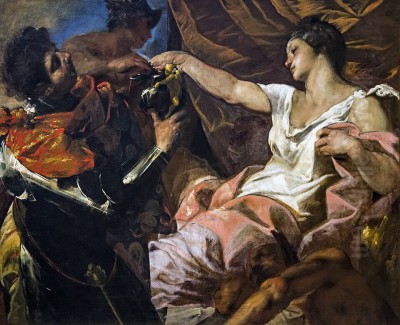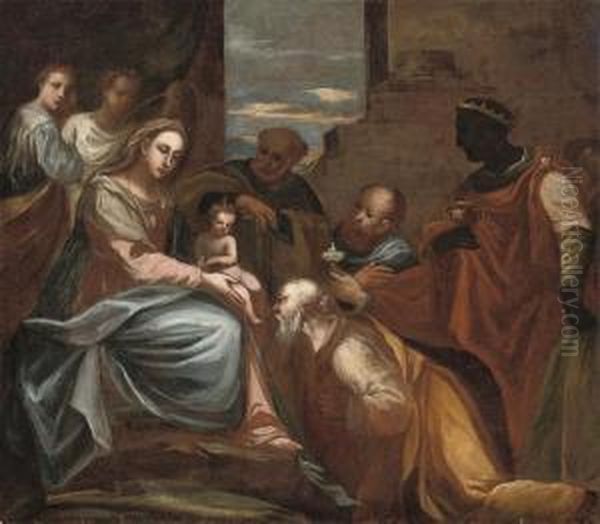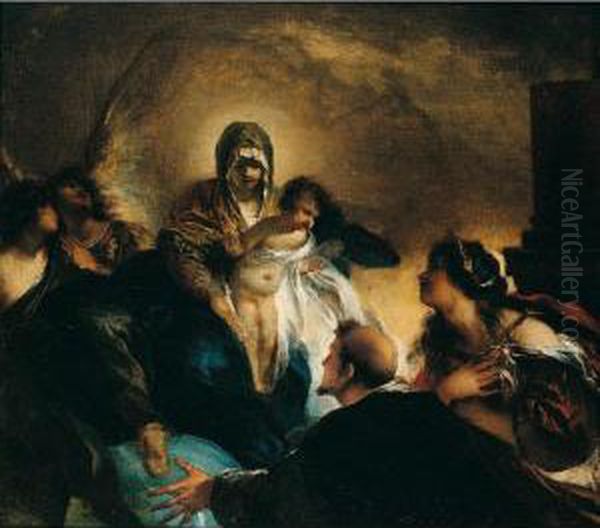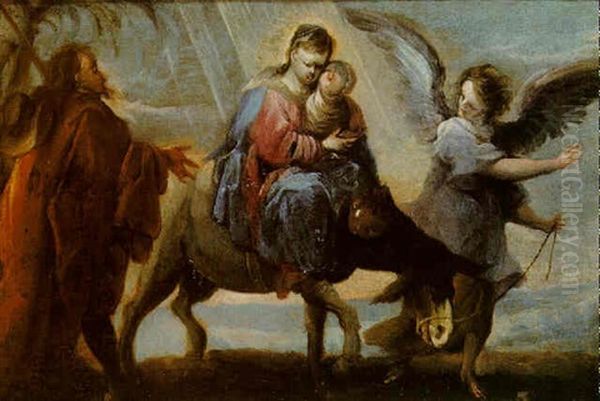
Francesco Maffei stands as a fascinating and somewhat enigmatic figure in the vibrant tapestry of 17th-century Italian Baroque art. Active primarily in Vicenza, his birthplace, and later in Venice and Padua, Maffei developed a distinctive style characterized by dramatic compositions, energetic brushwork, and a rich, often audacious, use of color. Though perhaps not as universally recognized today as some of his contemporaries, his work represents a crucial link in the evolution of Venetian painting, absorbing the grandeur of the High Renaissance masters while infusing it with the dynamism and emotional intensity of the Baroque era. His artistic journey reflects a restless creativity, drawing from diverse influences to forge a unique visual language that continues to intrigue art historians and enthusiasts alike.
Early Life and Artistic Formation in Vicenza
Born in Vicenza around 1605 (though some earlier sources suggest 1600), Francesco Maffei's initial artistic training took place in his native city. He was a pupil of Alessandro Maganza, a local painter of some repute whose workshop was a significant artistic hub in Vicenza. Maganza himself was steeped in the traditions of late Mannerism, and his influence likely provided Maffei with a solid grounding in compositional principles and technique. However, Vicenza, while possessing its own artistic identity, was also profoundly influenced by the artistic giants of nearby Venice.
During these formative years, Maffei would have been exposed to the monumental works of 16th-century Venetian masters. The profound impact of painters like Jacopo Tintoretto, with his dramatic use of light and shadow (chiaroscuro) and daring perspectival constructions, is evident in Maffei's later development. Similarly, the opulent color palettes and grandiloquent narrative scenes of Paolo Veronese left an indelible mark on the young artist. The rich, earthy tones and pastoral sensibilities of Jacopo Bassano and his prolific family workshop, also active in the Veneto region, would have further enriched Maffei's visual vocabulary. These early encounters with the Venetian school's emphasis on "colorito" (color and painterly application) over the Florentine and Roman emphasis on "disegno" (drawing and design) were fundamental in shaping his artistic trajectory.

Maffei's early works from this Vicentine period, while showing the influence of his teacher and the aforementioned masters, already hinted at an individual temperament. There was a burgeoning energy, a tendency towards elongated figures, and a certain theatricality that would become more pronounced as his career progressed. He began to establish a local reputation, undertaking commissions for churches and private patrons in Vicenza and the surrounding region.
The Venetian Crucible: New Influences and Stylistic Maturation
Around 1638, Francesco Maffei made a pivotal move to Venice. This relocation was crucial for his artistic development, as Venice was a melting pot of artistic ideas and a center of patronage. In the lagoon city, Maffei came into direct contact with the works of contemporary painters who were themselves reinterpreting the Venetian tradition in light of new Baroque trends emanating from Rome and other Italian centers.
Three artists, in particular, are often cited as significant influences on Maffei during his Venetian sojourn: Domenico Fetti, Bernardo Strozzi, and the German-born Johann Liss. Domenico Fetti, who had worked in Mantua before coming to Venice, was known for his small-scale biblical scenes imbued with a sense of immediacy and rich, painterly textures. Bernardo Strozzi, originally from Genoa, brought a robust, Rubensian vitality and a vibrant, almost incandescent, color sense to Venetian art. Johann Liss, though his career was tragically cut short by the plague, introduced a sensuous, almost Rococo-like delicacy and a flickering, atmospheric light to his compositions.
The impact of these artists on Maffei was transformative. He absorbed Strozzi's energetic brushwork and heightened colorism, Fetti's narrative intensity, and Liss's dynamic compositions and dramatic lighting. This period saw Maffei's style coalesce into something uniquely his own: a potent, sometimes eccentric, fusion of Venetian color, Mannerist elongation, and Baroque dynamism. His brushwork became even more rapid and visible, imbuing his canvases with a sense of urgency and movement. His figures often possess an almost nervous energy, their gestures dramatic and their expressions intense. This synthesis resulted in a style that was both deeply rooted in Venetian tradition and strikingly modern in its expressive freedom.
Characteristics of Maffei's Artistic Style

Francesco Maffei's art is characterized by several distinctive features that set him apart. His use of color is particularly noteworthy. While drawing on the rich Venetian palette, Maffei often employed unexpected juxtapositions and almost startlingly bright hues, creating a vibrant, shimmering effect. His colors are not merely descriptive but are used to heighten the emotional impact of his scenes, contributing to their theatricality and drama. This approach, sometimes described as "pre-Rococo" in its luminosity and freedom, anticipates later developments in Venetian painting.
His brushwork is equally distinctive – rapid, sketchy, and highly visible. This "pittura di tocco" (painting of touch) or "sprezzatura" (a studied carelessness) lends his works an extraordinary vitality and immediacy. It suggests a swift, almost improvisational, execution, though this was likely a carefully cultivated effect. This technique allowed him to capture fleeting moments and dynamic action with remarkable verve. However, this very rapidity, and perhaps his experimental mixing of pigments, has been cited as a possible reason for the poor preservation of some of his works over time.
Compositionally, Maffei favored dynamic, often asymmetrical arrangements. His figures are frequently depicted in complex, swirling movements, their bodies elongated and their gestures expressive. He had a penchant for dramatic foreshortening and bold perspectival effects, further enhancing the sense of energy and movement in his paintings. There is often a sense of restlessness, a "furor" or passionate intensity, that pervades his canvases, whether depicting religious martyrdoms, mythological dramas, or allegorical narratives. This dramatic flair, combined with a certain elegance that could sometimes border on the fantastical or even bizarre, makes his work instantly recognizable. Some art historians note a subtle balance of "artifice" or theatricality, a departure from strict naturalism that aligns with both late Mannerist tendencies and Baroque rhetoric.
Key Themes and Subject Matter
Like many artists of his time, Francesco Maffei tackled a wide range of subjects, though religious and mythological themes dominate his oeuvre. He produced numerous altarpieces and large-scale narrative paintings for churches in Vicenza, Venice, Padua, Rovigo, and Brescia. These works often depict scenes of martyrdom, miracles, and ecstatic visions, providing ample opportunity for his dramatic and emotionally charged style.
Biblical narratives, such as the Adoration of the Magi (Vicenza Cathedral), allowed him to explore complex multi-figure compositions and rich, exotic details. His depictions of saints, like Saint Catherine (formerly in the Church of San Michele, Vicenza) or Saint Anne (Vicenza), often emphasize their spiritual fervor through dynamic poses and intense expressions. The now-damaged fresco of "Paradise" in the church of San Francesco in Padua, despite its condition, was noted for its brilliant color and ambitious scope.

Mythological and allegorical subjects also provided fertile ground for Maffei's imagination. These themes allowed for a greater degree of freedom in depicting the human form and exploring complex symbolic meanings. His painting Perseus and Medusa, now housed in the Gallerie dell'Accademia in Venice, is a prime example of his ability to imbue a classical myth with Baroque energy and psychological tension. The swirling composition, the dramatic interplay of light and shadow, and the expressive figures all contribute to the painting's powerful impact. He also created numerous allegorical works, whose specific meanings can sometimes be elusive today but which invariably showcase his inventive compositions and vibrant palette.
Notable Works: A Closer Look
Several key works exemplify Francesco Maffei's artistic achievements and stylistic peculiarities.
Perseus and Medusa (Gallerie dell'Accademia, Venice): This painting is a quintessential example of Maffei's mature style. It captures the dramatic climax of the myth, with Perseus, aided by Athena and Hermes, about to slay the Gorgon Medusa. The composition is a whirlwind of movement, with figures arranged along dynamic diagonals. Perseus, muscular and heroic, lunges forward, his shield reflecting Medusa's horrifying face. Medusa herself is a figure of tragic power, her snake-hair writhing. The colors are rich and luminous, with flashes of brilliant red and gold against darker, atmospheric tones. The rapid, energetic brushwork contributes to the scene's visceral impact.
The Martyrdom of Saint John the Baptist (c. 1640-1645): While the exact location of this work can vary in attribution or if multiple versions exist, paintings by Maffei on the theme of martyrdom are central to his output. Such a work would typically showcase his ability to convey intense emotion and physical suffering through dramatic gestures, contorted figures, and a heightened sense of theatricality. The interplay of light and shadow would be employed to focus attention on the central drama, and the surrounding figures would react with a mixture of horror, pity, and fanaticism, characteristic of Baroque depictions of martyrdom.
Adoration of the Magi (Vicenza Cathedral): This subject, a favorite of Venetian painters for its opportunities to display rich costumes, exotic figures, and complex groupings, would have allowed Maffei to demonstrate his mastery of color and composition on a grand scale. One can imagine a vibrant canvas filled with sumptuously dressed kings, their retinue, and the Holy Family, all rendered with Maffei's characteristic energetic brushwork and luminous palette. The scene would likely be imbued with a sense of awe and wonder, fitting for the sacred event.

Altarpieces in Vicenza and Padua: Maffei executed numerous altarpieces for churches in his native region. Works like Saint Catherine and Saint Anne in Vicenza, or commissions for churches in Padua, demonstrate his ability to adapt his style to the devotional needs of his patrons while retaining his artistic individuality. These paintings often feature soaring compositions, with saints and divine figures appearing in dramatic, light-filled visions. Even when damaged, as in the case of the "Paradise" fresco in Padua, the ambition and brilliance of his conceptions are often still discernible.
The preservation of Maffei's works has unfortunately been inconsistent. Some scholars attribute this to his sometimes hasty execution or his experimental use of pigments, which may not have stood the test of time well. This makes the surviving, well-preserved examples of his art all the more precious for understanding his unique contribution.
Later Years, Literary Pursuits, and Legacy
In 1657, Francesco Maffei moved from Venice to Padua, a city with a distinguished university and a rich artistic heritage. It was here that he spent the final years of his life. Tragically, his career and life were cut short when he succumbed to the plague in 1660.
Beyond his prolific output as a painter, Maffei is also noted to have had literary interests. Some accounts suggest he wrote poetry, though it remained unpublished, possibly due to the prevailing literary tastes or restrictions of the era. There are also mentions of his involvement with intellectual circles, including a connection to the Arcadian Academy in Rome and an attempt to establish a branch in Verona. He is even said to have co-edited the Giornale de' letterati d'Italia for a time, resigning due to health reasons. While these aspects of his life are less documented than his painting career, they suggest a man of broad intellectual curiosity.
Francesco Maffei's legacy is complex. For a period, his work was somewhat overshadowed by the more famous names of the Venetian school. However, 20th-century art historical scholarship has led to a significant re-evaluation of his contributions. He is now recognized as a highly original and inventive artist who played a key role in the development of Venetian Baroque painting. His eclectic style, drawing from a multitude of sources yet forging them into something new and personal, makes him a fascinating case study in artistic synthesis.
One interesting aspect of his practice was his engagement with printmaking. By having his own compositions reproduced as prints, he not only disseminated his artistic ideas more widely but also provided models for younger artists to study and emulate. This contributed to the broader diffusion of Baroque stylistic trends.
Maffei's Place in the Pantheon of Art History

Francesco Maffei occupies a unique niche in the history of Italian art. He was not a revolutionary figure in the mold of Caravaggio, who dramatically altered the course of painting with his stark naturalism and tenebrism, nor did he establish a large, dominant workshop like that of Annibale Carracci in Rome, who championed a more classical form of Baroque. Instead, Maffei's contribution lies in his spirited and individualistic interpretation of the Venetian tradition within the broader context of the European Baroque.
His art can be seen as a bridge between the grandeur of the Venetian Renaissance and the more exuberant, decorative tendencies of the later Baroque and Rococo periods. Indeed, some of the dynamism and luminous color of his work seem to anticipate the achievements of later Venetian masters like Giambattista Tiepolo. He shared with contemporaries like Peter Paul Rubens (though their paths didn't directly cross in the same circles) a love for dynamic movement and rich color, though Maffei's style remained distinctly Italian and Venetian. Even when compared to a Northern contemporary like Rembrandt van Rijn, whose dramatic use of light and psychological depth defined a different Baroque sensibility, Maffei's commitment to color, theatricality, and energetic brushwork highlights the diverse expressions of the Baroque spirit across Europe.
His willingness to experiment, his sometimes eccentric figural types, and his sheer painterly verve distinguish him from many of his contemporaries. While his works were sometimes mistaken for those of Veronese or Fetti, this speaks more to the shared artistic currents of the time and Maffei's ability to absorb and transform influences rather than a lack of originality. Today, art historians appreciate Maffei for his bold, expressive power and his role in keeping Venetian painting vital and innovative during the 17th century. His works, found in churches and museums primarily in the Veneto region but also in international collections, continue to captivate viewers with their restless energy and dazzling visual appeal.
Conclusion: The Enduring Vibrancy of Francesco Maffei
Francesco Maffei was an artist of considerable talent and originality, a key exponent of the Venetian Baroque whose work is characterized by its dynamism, rich color, and expressive intensity. From his early training in Vicenza under Alessandro Maganza to his mature period in Venice, where he absorbed the influences of Strozzi, Fetti, and Liss, Maffei forged a distinctive artistic voice. He masterfully blended the heritage of Venetian Renaissance masters like Tintoretto and Veronese with the new dramatic impulses of the Baroque.
His paintings, whether depicting stirring religious narratives like The Martyrdom of Saint John the Baptist, vibrant mythological scenes such as Perseus and Medusa, or grand altarpieces, are imbued with a characteristic energy and theatrical flair. Though the preservation of some of his works has been challenging, and his biography contains elements of mystery, his artistic legacy is undeniable. Francesco Maffei remains a compelling figure, an artist whose passionate and often audacious canvases offer a vivid glimpse into the rich artistic ferment of 17th-century Venice and affirm his place as a significant, if sometimes underappreciated, master of the Italian Baroque. His art continues to resonate with a vibrancy that transcends time, inviting ongoing study and appreciation.